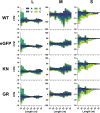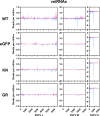Dicer-2 mutations in Aedes aegypti cells lead to a diminished antiviral function against Rift Valley fever virus and Bunyamwera virus infection
- PMID: 39508739
- PMCID: PMC11542633
- DOI: 10.1099/jgv.0.002046
Dicer-2 mutations in Aedes aegypti cells lead to a diminished antiviral function against Rift Valley fever virus and Bunyamwera virus infection
Abstract
Mosquitoes are known to transmit different arthropod-borne viruses belonging to various virus families. The exogenous small interfering RNA pathway plays an important role in the mosquito defence against such virus infections, with Dicer-2 (Dcr2) as one of the key proteins that initiates the cleavage of viral dsRNAs into 21 nt long virus-derived small interfering RNAs. Previous data identified the importance of various motifs in Dcr2 for its small interfering RNA (siRNA)-mediated antiviral activity. However, all these data focus on positive-strand RNA viruses, although negative-strand RNA viruses, like Bunyaviricetes, include several important mosquito-borne viruses. Here, we aim to investigate the importance of different domains of Dcr2 for antiviral activity against viruses of the Bunyaviricetes. For this, we used the Aedes aegypti-derived Dcr2 knock-out cell line Aag2-AF319 to study the importance of the helicase, RNase III and PIWI-Argonaute-Zwille domains of Dcr2 on the antiviral activity of two viruses belonging to different families of the Bunyaviricetes: the Rift Valley fever virus (RVFV) vaccine strain MP12 (Phenuiviridae, Phlebovirus) and the Bunyamwera orthobunyavirus (BUNV; Peribunyaviridae, Orthobunyavirus). All three domains were determined to be critical for the antiviral activity against both RVFV and BUNV. Interestingly, one specific mutation in the helicase domain (KN) did not result in a loss of antiviral activity for RVFV, but for BUNV, despite losing the ability to produce 21 nt siRNAs.
Keywords: Bunyaviricetes; Dcr2; RVFV; antiviral RNAi; arbovirus; mosquito.
Conflict of interest statement
The authors declare no conflicts of interest.
Figures




Similar articles
-
Mutational analysis of Aedes aegypti Dicer 2 provides insights into the biogenesis of antiviral exogenous small interfering RNAs.PLoS Pathog. 2022 Jan 6;18(1):e1010202. doi: 10.1371/journal.ppat.1010202. eCollection 2022 Jan. PLoS Pathog. 2022. PMID: 34990484 Free PMC article.
-
The PAZ domain of Aedes aegypti Dicer 2 is critical for accurate and high-fidelity size determination of virus-derived small interfering RNAs.RNA. 2025 Apr 16;31(5):679-691. doi: 10.1261/rna.080149.124. RNA. 2025. PMID: 39947927 Free PMC article.
-
Dicer-2- and Piwi-mediated RNA interference in Rift Valley fever virus-infected mosquito cells.J Virol. 2013 Feb;87(3):1631-48. doi: 10.1128/JVI.02795-12. Epub 2012 Nov 21. J Virol. 2013. PMID: 23175368 Free PMC article.
-
Molecular biology and genetic diversity of Rift Valley fever virus.Antiviral Res. 2012 Sep;95(3):293-310. doi: 10.1016/j.antiviral.2012.06.001. Epub 2012 Jun 16. Antiviral Res. 2012. PMID: 22710362 Free PMC article. Review.
-
Single-cycle replicable Rift Valley fever virus mutants as safe vaccine candidates.Virus Res. 2016 May 2;216:55-65. doi: 10.1016/j.virusres.2015.05.012. Epub 2015 May 27. Virus Res. 2016. PMID: 26022573 Free PMC article. Review.
References
MeSH terms
Substances
LinkOut - more resources
Full Text Sources
Research Materials

